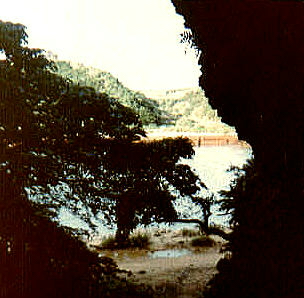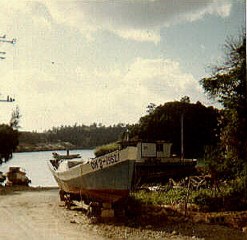Battle For Okinawa: World War II | home
" Shinyo "
|
Suicide attack boats, called "Shinyo," carrying 550 pounds of explosives in their bows,
were planned to strike from hiding places along the shore on Okinawa
 Okinawa's Suicide Boat Bay
Okinawa's Suicide Boat Bay Japanese Suicide Boat Plans
Japanese Suicide Boat PlansNote the river which flows from left to right; and the islands in the far distance. US Forces set up artillery batteries on the island and shelled Okinawa from a very safe distance; having no measurable forces to contend with. It was said that one Japanese General on these outer islands informed the Americans if they would leave him and his men alone; then he would leave them alone; and he kept his word.But; tucked away down that river were Japanese Kamikaze Boat Pilots.
The Japanese had devised a plan to load-up high-speed motorboats with high explosives and have them attack the American Fleet. Their mission was to penetrate the ships' defenses coming in quickly under the guns and ramming the ships; they would blow themselves and the ships to kingdom come. In light of the recent USS Cole disaster it isn't as far-fetched as it sounded at the time. The boats were hidden in caves up that river and pulled inside along 'railroad tracks'.
The plan never was carried out, however.

Suicide-Boat Storage
About a half-dozen suicide-boat storage caves overlook this cove, at just above waterline. Here's a view from inside the caves.
Locals said that during the war the Japanese made 'doors'
to hide the caves and that the US Forces never knew they were there until the invasion along Yellow Beach
The Caves were dug into the cliff sides which line the bay and possibly had 'rails' build to the sea from which to launch the boats quickly


The Suicide Boat Caves were dug into the hillside left; Dragon-Boat Design of the local Fishermen
Any Japanese Suicide Boats would have been impossible to 'discover' unless you walked right up on one.
And that is how they were found; still packed with explosives.
 Note Wheels on the bottom of the Dragon-Boat
Note Wheels on the bottom of the Dragon-BoatThe same design is used throughout the islands
in most if not all of these fishing bays
The boats are removed from the bays using a small
'donkey' or 'slave-motor' and winch.
The fishermen would lower the boats into the water and untie the wheels, the ropes would float on the surface; when they came back they would re-tie the wheels and fire up the engines
used to pull their boats out of the water. The Japanese
were no strangers to the sea and easily adopted this idea